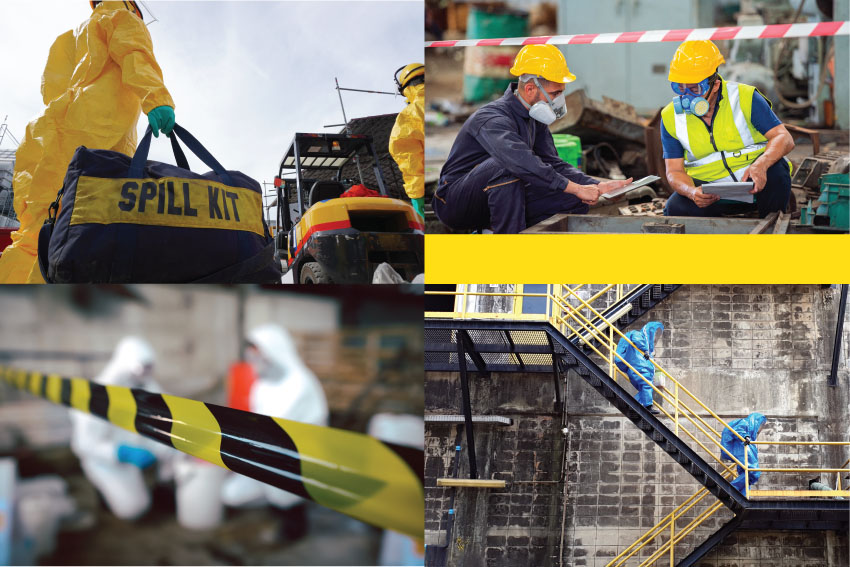
There are several different workplaces, including laboratories and even school classrooms, that deal with chemicals on a regular basis. When this is the case, you must be prepared with an adequate chemical spillage procedure.
Below, we’ll explain how to deal with chemical spills in the workplace, including the different types of chemical spills and putting together a chemical spill kit.
Types of Chemical Spills
There are two types of chemical spills that you might encounter: a minor chemical spill, and a major chemical spill.
Minor spills are small tips that are typically confined and do not pose an immediate hazard to those nearby. These spills are typically quite easy to take care of as there is no imminent danger involved, provided caution is taken in addressing the liquid.
Major spills, on the other hand, are anything that makes the chemical difficult to deal with. Usually, major chemical spills are situations where a large amount of the chemical has been spilt, the chemical in question is unidentified, or multiple chemicals have been spilt. Extra care must always be taken when dealing with a major chemical spill.
How to Deal with a Chemical Spill
There should be four main stages to your responsive chemical spillage procedure, in line with Occupational Safety & Health Administration (OSHA) chemical spill procedures:
- Evacuate and Inform: The first thing you need to do is get anyone nearby safely away from the chemical spill and alert the relevant personnel.
- Secure the Area: Now that everyone’s safely away from the hazard, section it off to prevent anyone from getting close, and open any windows to ventilate the room. If possible, relocate anything that may react with the spill. However, if doing so will put you in danger, leave the area.
- Contain the Chemicals: The most important thing is to keep yourself safe. If you do plan on getting close, make sure you’re wearing the correct PPE. Cover any drains with drain seals, and activate a containment barrier, if possible.
- Clean Up: Use absorbent mats and pillows to soak up as much of the spill as possible, then dispose of them safely in a chemical waste container. Use water to rinse the area afterwards, then clean it as normal.
In carrying out these steps, it’s particularly useful to have a chemical spill kit to hand.
What is a Chemical Spill Kit?
A chemical spill kit is a set of equipment kept together for easy access when needing to treat a chemical spill. They’re designed to limit the spread of a spill and clean it up easily.
Although the contents of a spill kit will vary between each one, you will generally find the following in a kit:
- Disposable PPE (goggles, gloves, and waste bags)
- Caution tape
- Twist ties, absorbent pillows, mats, pads, and/or socks
- A bin to dispose of the materials
- Caution signage
A spill kit should be part of your emergency response plan following a COSHH risk assessment. Being able to quickly undergo your chemical spillage procedure is the most effective way of keeping everyone safe following a chemical spill.
Chemical spill kits will usually be kept near spill risk areas, so employers should identify where these might be. Any areas at risk of a chemical spill should be correctly signposted, as should the location of the nearest chemical spill kit.
How to Prevent Chemical Spills
The best way to prevent chemical spills is by storing and signposting chemicals correctly. Hazardous chemicals should always be in containers under some kind of cover or inside where they’re protected from rainfall and other weather, as this could dilute the chemicals and cause them to spill over.
To make sure that employees and visitors act responsibly around hazardous chemicals, they should be correctly labelled and signposted to ensure that everyone is aware of the nearby risk. You can use our chemical hazard warning signs to do so.
Furthermore, staff training should be provided for the handling of hazardous chemicals, and what to do in the event of a spill.
Minimise Chemical Spills with Label Source
With Label Source, you can find all the signs and labels you need to keep the workplace as safe as possible. This includes chemical hazard warning signs to let people know of nearby chemical hazards, as well as PPE signs should they need to handle dangerous chemicals.
Stay up to date with all the latest safety information by checking out our blog.